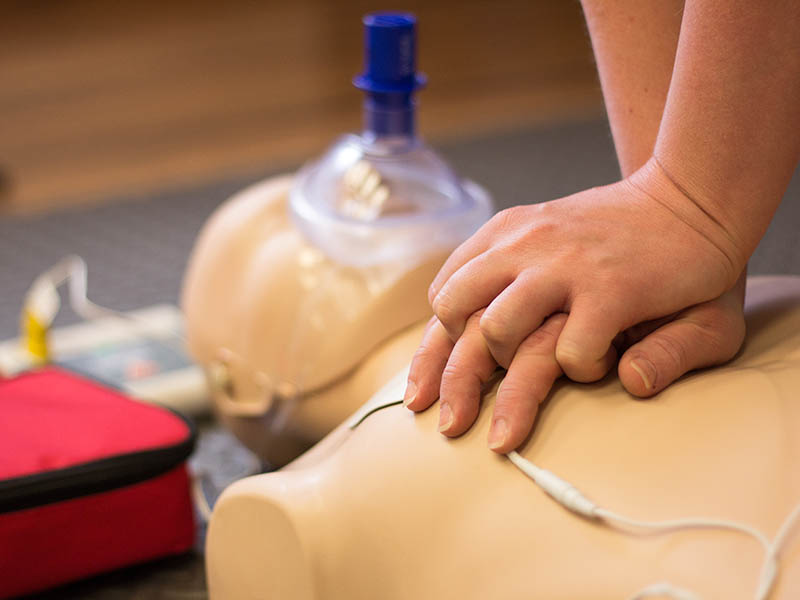梦想过成为英雄吗?某人突然冒出来拯救世界——或者拯救一条生命?实现这个梦想的最好机会可能是花点时间学习徒手心肺复苏术。
即使拯救别人的生命的想法让你感到害怕,无论如何还是要去尝试。如果你身边有人在家,在工作或在公共场合突发心脏骤停,你可能是他们唯一的生存机会。
Cardiac arrest is a heart malfunction that disrupts the flow of blood to the brain, lungs and other organs. The U.S. sees more than 350,000 out-of-hospital cardiac arrests every year, according to the American Heart Association. And about 90% of those people die. But if someone performs CPR on them until professional help arrives, their chance of surviving increases by two to three times.
Tyler Kientopf, the lead EMS educator forSanford Health in Bismarck, has been a paramedic for 12 years in rural and urban settings. His department manages American Heart Association training, including using CPR.
Kientopf estimates that in his career as a paramedic, he has seen fewer than 15% of sudden cardiac arrest victims survive. “Those that did survive were fortunate to have high-quality bystander CPR, or help was within seconds to minutes away,” he said. “… Every time I’ve seen a case like that, it usually has something to do with someone knew how to act and was prepared to act.”
Here’s what to do (yes, it’s really this easy)
The American Heart Association says hands-only CPR is this fast and easy, with no mouth-to-mouth breathing required:
- Call 911,or have someone else call, if you see a teen or adult suddenly collapse.
- Push hard and fast以每分钟100-120拍的节奏在胸腔中央。比如比吉斯乐队的《Stayin’Alive》、碧昂斯和Jay-Z的《Crazy in Love》、约翰尼·卡什的《Walk the Line》,甚至还有《Baby Shark》。”
“People feel more comfortable with one or two steps,” Kientopf said. “When you start having to think and remember (breathing-to-compression) ratios, people are more hesitant to respond and react. So when we talk about hands-only CPR, all we’re asking you to do is find the center of the chest and then press hard and fast.”
Hands-only CPR requires no special course. It is for use only with teen and adults experiencing sudden cardiac arrest, not for infants or children.
In addition, Kientopf said people can watch for the opportunity to practice chest compressions. American Heart Association booths are set up at various community events with mannequins to give people feedback on the depth of their chest compressions. “That type of practice takes minutes,” he added.
Hands-only CPR does work
Even if you’re not sure the person who collapsed is in cardiac arrest, the American Heart Association recommends starting hands-only CPR. You are likely the person’s only chance of surviving until help arrives if it is cardiac arrest. If it isn’t, then hands-only CPR could still help the person start responding — they might begin to move, breathe normally or speak. Then you can stop compressions.
A June incident helps illustrate the value of hands-only CPR in improving the chances of survival.F-M Ambulance Service(Fargo, North Dakota, and Moorhead, Minnesota) recently handed out its Citizen Lifesaving Award to four people who were instrumental in saving the life of a man who had sudden cardiac arrest while he was out golfing, according to a post on the ambulance’s Facebook page.
A friend in his group immediately started chest compressions, despite never having learned CPR. Another bystander, who had been certified in CPR long before, arrived and took over chest compressions. Police and fire department personnel then came and used an AED. Finally, paramedics with F-M Ambulance took over with an automatic CPR machine.
In all, the man’s heart had stopped for 45 minutes, the Facebook post said. But he likely can attribute his survival partly to the immediate hands-only CPR administered by his friend.
‘You can’t make the situation any worse’
“Two steps to save a life: dialing 911 and pushing hard and fast on the chest. Those two things truly make a difference, and we see it every day across the nation,” Kientopf said. “So I would encourage people to take the time to seek out hands-only CPR training to better their community, and then even maybe seek out acertification courseto enhance that knowledge.”
A course to learn CPR with breaths can give you confidence and high-quality chest compression skills. It can also enable you to help infants, children, drowning or drug overdose victims, and people who have collapsed from breathing problems.
Kientopf shares advice with his students that can apply to any bystander hesitating to step in if someone collapses.
“你不能让情况变得更糟,所以对你来说,试着做点什么总比什么都不做要好。”
Learn more
- Heart screenings protect against disease, save lives
- Coronary calcium screening reveals hidden heart problems
- Take a CPR course at Sanford Health
…
Posted InEmergency Medicine,Health Information,Heart
